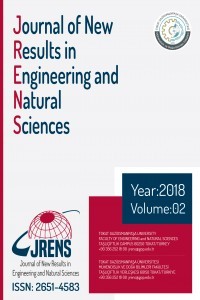DI Bir Dizel Motorunda Optimum Buhar Püskürtme Oranı ve Yakıt Püskürtme Zamanının Taguchi Metodu ile Deneysel Olarak Belirlenmesi
Buhar enjeksiyonu, Püskürtme avansı, Performans, Emisyonlar .
Determination with Taguchi Method of Optimum Steam Injection Rate and Fuel Injection Timing in a DI Diesel Engine Experimentally
Steam injection, Fuel injection timing, Engine performance, Emissions .,
___
- [1] V. Ayhan., “Bir Dizel Motoruna Buhar Enjeksiyonunun NOx Ve İs Emisyonlarına Etkisinin Araştırılması”, SAÜ, FBE, Doktora Tezi,2009.
- [2] V. Ayhan, İ. Cesur, A. Parlak, B. Boru, “Bir Dizel Motoruna Buhar Enjeksiyonunun Performansa Ve NOx Emisyonlarına Etkilerinin Araştırılması”, 10. Uluslararası Yanma Sempozyumu 9-10 Ekim 2008, Sakarya/Türkiye.
- [3] A.Parlak, V. Ayhan, İ. Cesur, B.Boru, “Kısmi Yük Şartlarında Çalışan Bir Dizel Motoruna Buhar Enjeksiyonunun Etkileri”, 11th International Combustion Symposium, 24-27 June, 2010,Sarajevo, Bosn
- [4] A.Parlak, V. Ayhan, Y. Üst, B.Şahin, İ.Cesur, B. Boru, “NOx Emisyonlarının Azaltılmasında Yeni Bir Yöntem: Elektronik Kontrollü Su Buharı Enjeksiyonu”, The First Global Conference on Innovation in Marine Technology And The Future of Maritime Transportation, 24-29 November, 2010, İstanbul-Turkey.
- [5] A.Parlak, V. Ayhan, İ. Cesur, B.Boru, “ Endirekt Enjeksiyonlu Bir Dizel Motoruna Buhar Enjeksiyonunun Etkilerinin Araştırılması”, 6th International Advanced Technologies Symposium (IATS’11), 16-18 Mayıs, 2011, Elazığ, Turkey.
- [6] F. L. Dryer, “Water addition to practical combustion systems concepts and applications.” 16th International Syposium on Combustion, The Combustion Institute, pp. 321–336, Cambridge MA, Aug. 1976.
- [7] M. Y. E. Selim, and S. M. S. Elfeky, “Effects of diesel/water emulsion on heat flow and thermal loading in a pre-combustion chamber diesel engine,” Applied Thermal Engineering., vol. 21, no.15, pp. 1565–1582, 2001.
- [8] A.Parlak,H.Karabaş, İ.Özsert, V.Ayhan, İ. Cesur, “Application of Taguchi’s Methods to Investigate Factors Affecting Exhaust Emissions of a Diesel Engines Running With Tobacco Seed Oil Methyl Ester Blends”, International Jornaul Of Vehicle Design. Int. J. Vehicle Design, Vol. 59, Nos. 2/3, 196-211, 2012.
- [9] Zhan-Yi Wu, Horng-Wen Wu, Cheng-Han Hung, Applying Taguchi method to combustion characteristics and optimal factors determination in diesel/biodiesel engines with portinjecting LPG, Fuel 117 (2014) 8–14.
- [10] B. Rajesh Kumar, S. Saravanan, Balaji Sethuramasamyraja, D. Rana, Screening oxygenates for favorable NOx/smoke trade-off in a DI diesel engine using multi response optimization, Fuel 199 (2017) 670–683.
- [11] T. Ganapathy, K. Murugesan, R.P. Gakkhar, Performance optimization of Jatropha biodiesel engine model using Taguchi approach, Applied Energy 86 (2009) 2476–2486.
- [12] Horng-Wen Wu*, Zhan-Yi Wu, Combustion characteristics and optimal factors determination with Taguchi method for diesel engines port-injecting hydrogen, Energy 47 (2012) 411-420.
- [13] S.Natarajan, K.Akash Trasy, N.Srihari, S.Raja, Effects of Injection Timing on CI Engine fuelled with Algae oil blend with Taguchi technique, Energy Procedia 105 ( 2017 ) 1043 – 1050.
- Yayın Aralığı: Yılda 2 Sayı
- Başlangıç: 2013
- Yayıncı: Tokat Gaziosmanpaşa Üniversitesi
Karınca Kolonisi Algoritması ile Yazılım Proje Takvimi Oluşturma
Vezir AYHAN, İbrahim ÖZSERT, Yusuf ÇAY, Aslan ÇOBAN, İdris CESUR
Kuantum Bilgisayarlarının Gerçekleştirildiği Sistemler
Mehpeyker KOCAKOÇ, Recep TAPRAMAZ
Kutrit Sistemlerde Hadamard Geçidi ile Yapılan Bazı İşlemler
Mehpeyker KOCAKOÇ, Recep TAPRAMAZ
Mostafa RANJBAR, Hakan ARSLAN, Oğuzhan KESKIN, Sezgin DEMIRTAŞ, Yunus Emre KARAKOCA
6 Sigma Süreç Yeterlilik İndeksi ile Adaptif PID Denetleyici Tasarımı
Mehmet Serhat CAN, Ömerül Faruk ÖZGÜVEN, Hüseyin ARPACI
Otomatik Ayarlamalı Sinir Hücresi ile Adaptif Kesir Dereceli PID Kontrolör Tasarımı
Hüseyin ARPACI, Ömerül Faruk ÖZGÜVEN, Mehmet Serhat CAN
Jet Boyama Makinesinin Termal Modeli
Lütfullah DAĞKURS, İsmail İŞERİ
Belirli Halkalar ve Grup Kodlar
Akıllı Şebekelerde Güvenli Haberleşme Tabanlı Güç Akışı Analizi
